Abstract
The bacteriophage phi X174 viral (+) origin when inserted in a plasmid can interact in vivo with the A protein produced by infecting phi X174 phages. A consequence of this interaction is packaging of single-stranded plasmid DNA into preformed phage coats resulting in infective particles (1). This property was used to study morphogenesis and to analyse the signals for initiation and termination of the rolling circle DNA replication in vivo. It is shown that the size of the DNA had a strong effect on the encapsidation by the phage coats and the infectivity of the particle. Termination was analysed by using plasmids with two phi X (+) origins either in the same orientation or in opposite orientation. Both origins were used with equal frequency. Initiation at one origin resulted in very efficient termination (greater than 96%) at the second origin in the case of two origins in the same orientation. When the two (+) origins have opposite orientations, no correct termination was observed. The second origin in the opposite strand effectively inhibits (greater than 98%) the normal DNA synthesis; i.e. the covalently bound A protein present in the replication fork interacts with the (+) origin sequence in the opposite strand.
Full text
PDF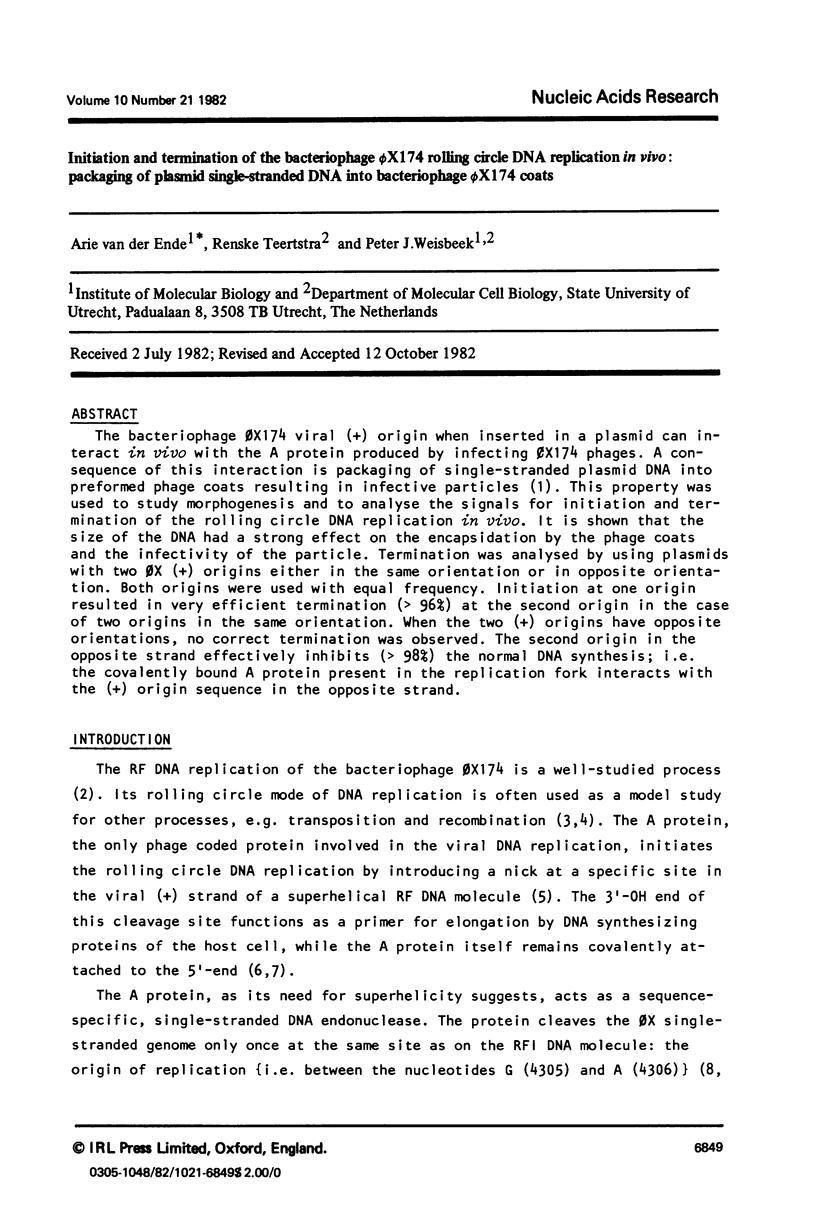
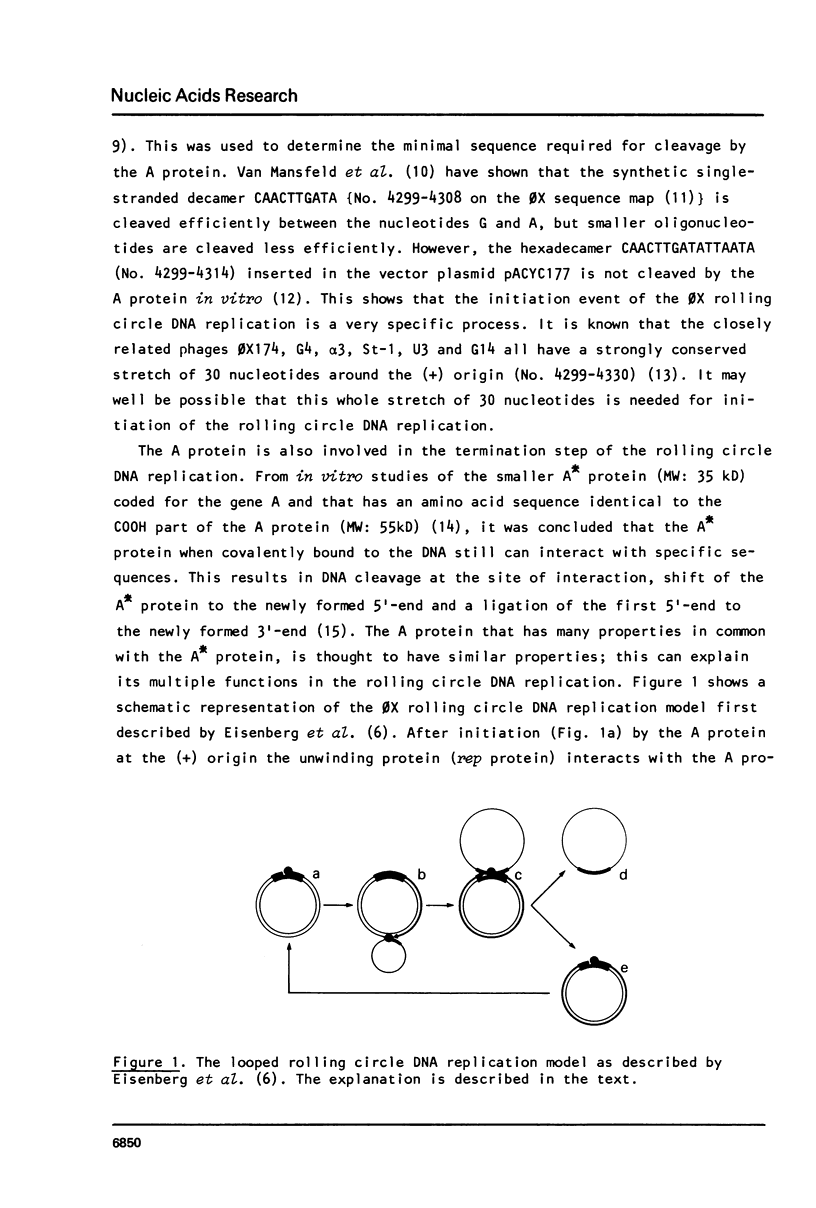

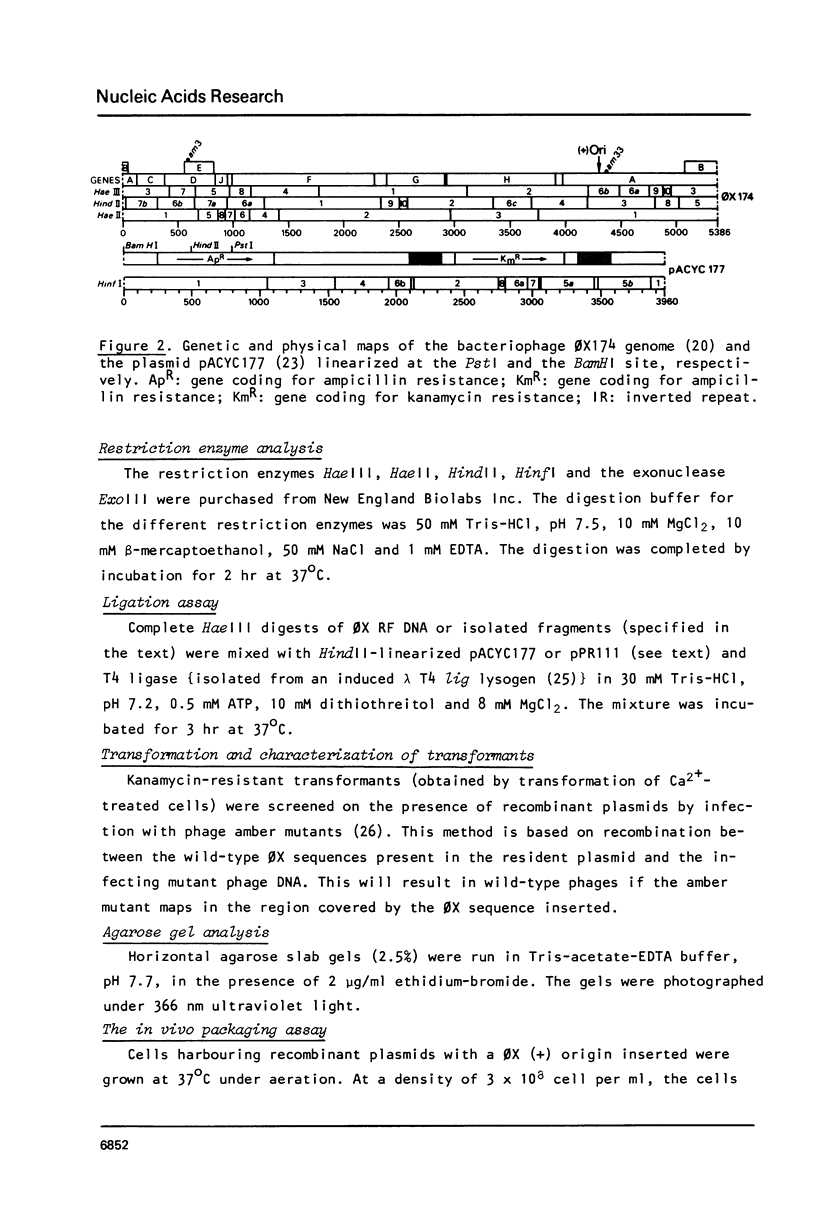
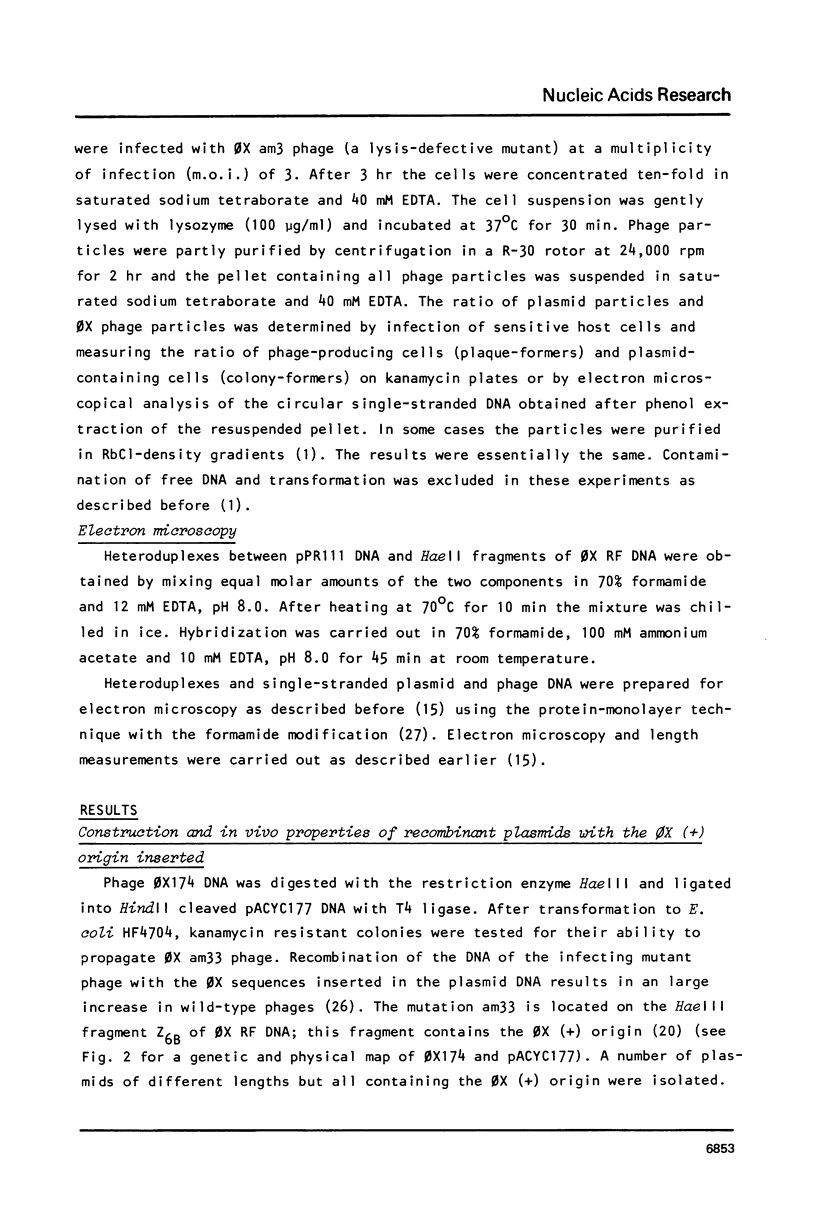
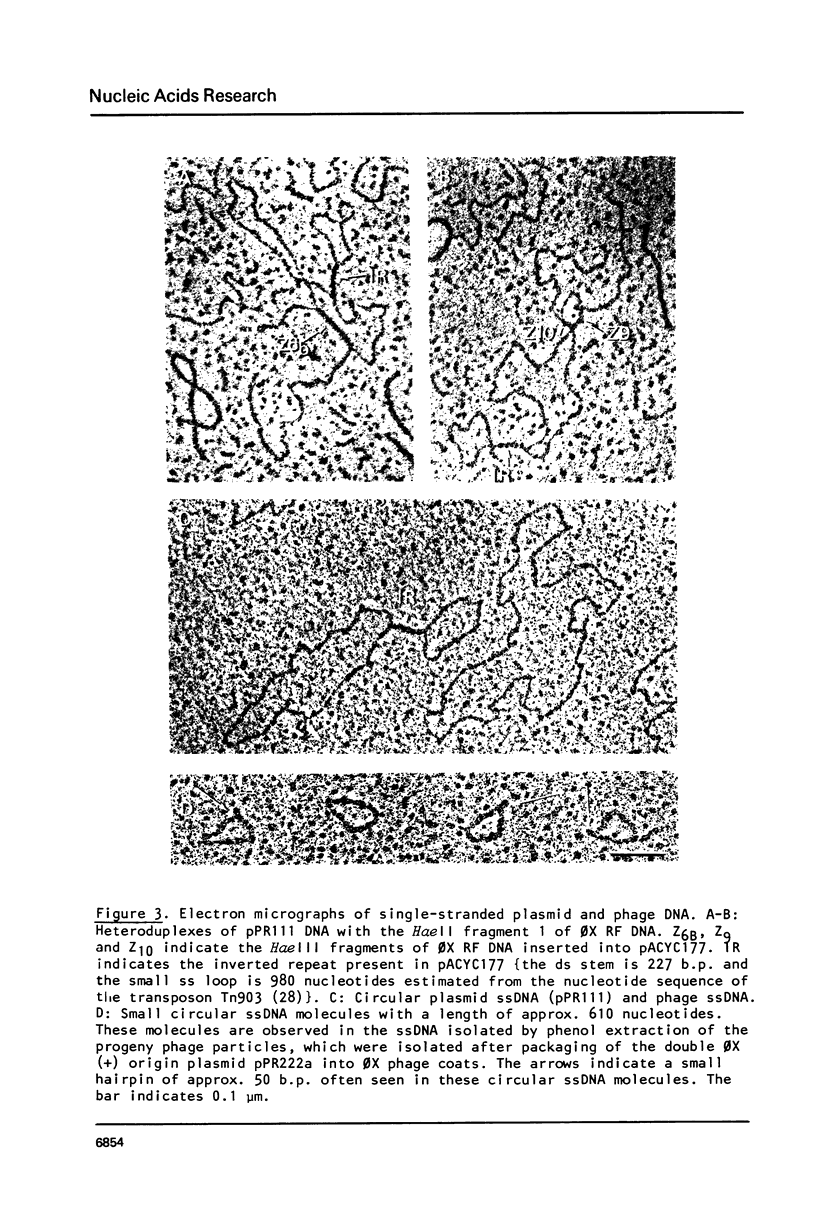

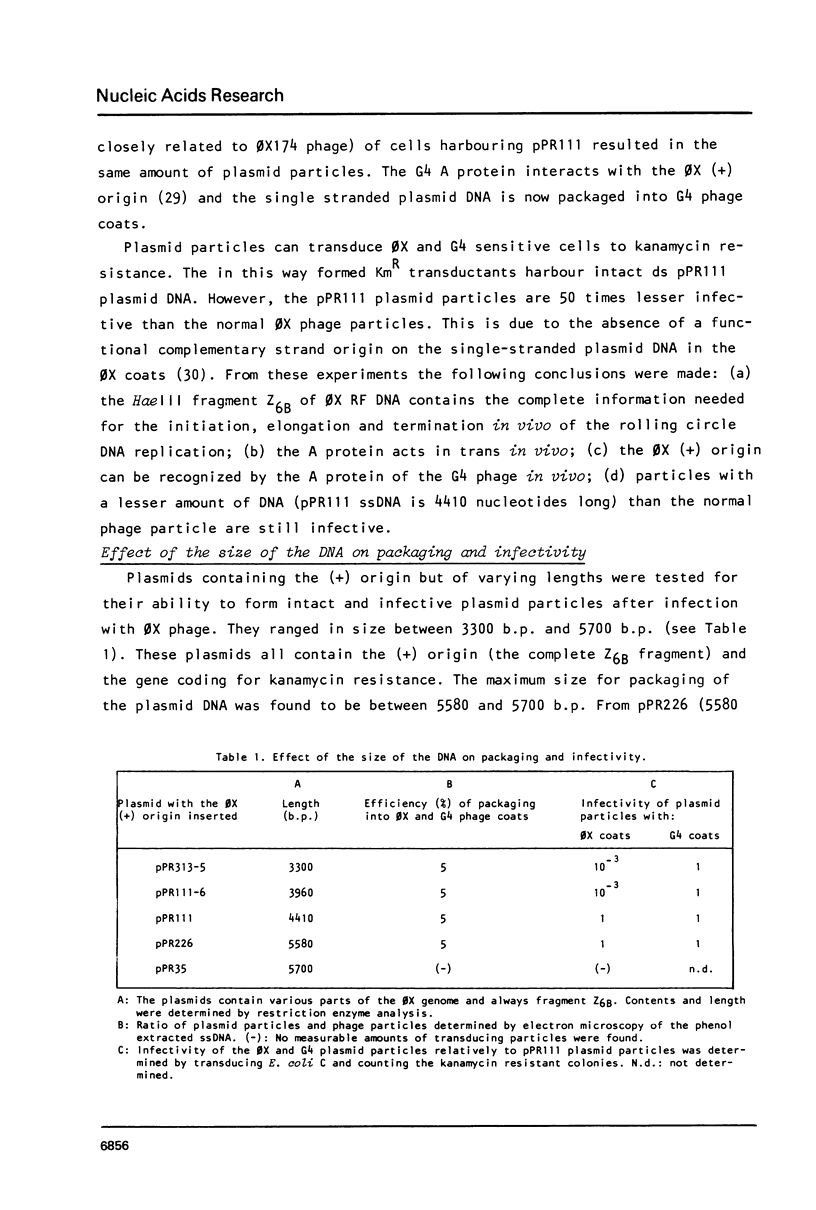
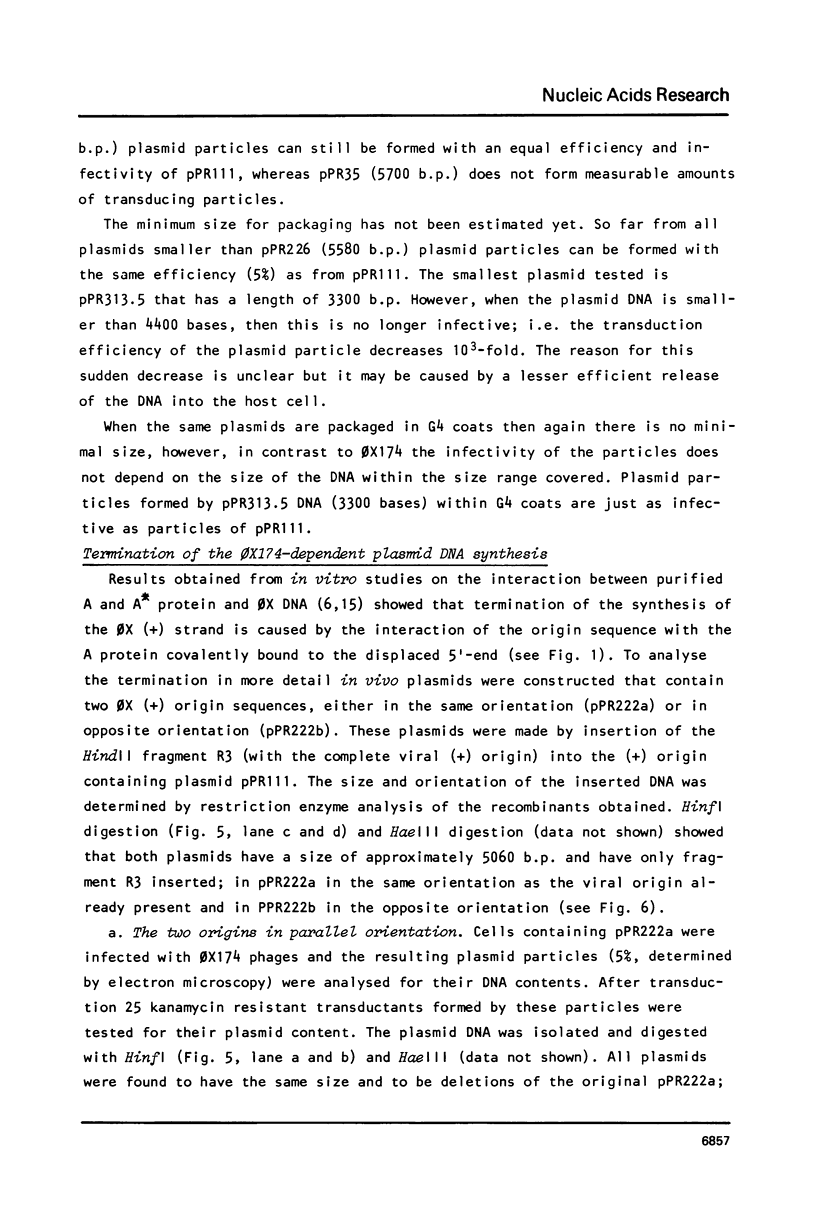

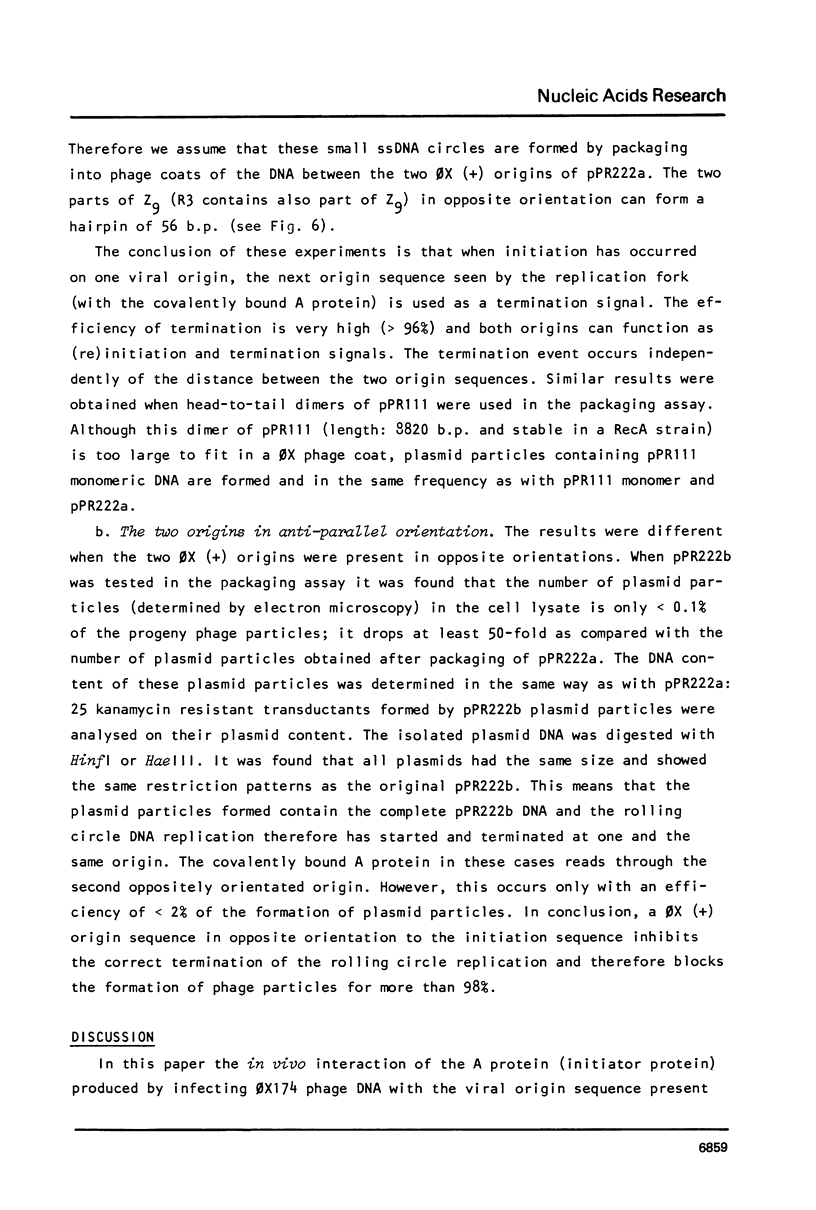




Images in this article
Selected References
These references are in PubMed. This may not be the complete list of references from this article.
- Arai N., Kornberg A. Rep protein as a helicase in an active, isolatable replication fork of duplex phi X174 DNA. J Biol Chem. 1981 May 25;256(10):5294–5298. [PubMed] [Google Scholar]
- Arai N., Polder L., Akai K., Kornberg A. Replication of phi X174 DNA with purified enzymes. II. Multiplication of the duplex form by coupling of continuous and discontinuous synthetic pathways. J Biol Chem. 1981 May 25;256(10):5239–5246. [PubMed] [Google Scholar]
- Birnboim H. C., Doly J. A rapid alkaline extraction procedure for screening recombinant plasmid DNA. Nucleic Acids Res. 1979 Nov 24;7(6):1513–1523. doi: 10.1093/nar/7.6.1513. [DOI] [PMC free article] [PubMed] [Google Scholar]
- Borrias W. E., Hagenaar M., Van Den Brekel R., Kühlemeijer C., Weisbeek P. J. Functional relationship between bacteriophages G4 and phi X174. J Virol. 1979 Aug;31(2):288–298. doi: 10.1128/jvi.31.2.288-298.1979. [DOI] [PMC free article] [PubMed] [Google Scholar]
- Chang A. C., Cohen S. N. Construction and characterization of amplifiable multicopy DNA cloning vehicles derived from the P15A cryptic miniplasmid. J Bacteriol. 1978 Jun;134(3):1141–1156. doi: 10.1128/jb.134.3.1141-1156.1978. [DOI] [PMC free article] [PubMed] [Google Scholar]
- Dotto G. P., Horiuchi K. Replication of a plasmid containing two origins of bacteriophage. J Mol Biol. 1981 Nov 25;153(1):169–176. doi: 10.1016/0022-2836(81)90532-5. [DOI] [PubMed] [Google Scholar]
- Eisenberg S., Griffith J., Kornberg A. phiX174 cistron A protein is a multifunctional enzyme in DNA replication. Proc Natl Acad Sci U S A. 1977 Aug;74(8):3198–3202. doi: 10.1073/pnas.74.8.3198. [DOI] [PMC free article] [PubMed] [Google Scholar]
- Francke B., Ray D. S. Formation of the parental replicative form DNA of bacteriophage phi-X174 and initial events in its replication. J Mol Biol. 1971 Nov 14;61(3):565–586. doi: 10.1016/0022-2836(71)90065-9. [DOI] [PubMed] [Google Scholar]
- Galas D. J., Chandler M. On the molecular mechanisms of transposition. Proc Natl Acad Sci U S A. 1981 Aug;78(8):4858–4862. doi: 10.1073/pnas.78.8.4858. [DOI] [PMC free article] [PubMed] [Google Scholar]
- Harshey R. M., Bukhari A. I. A mechanism of DNA transposition. Proc Natl Acad Sci U S A. 1981 Feb;78(2):1090–1094. doi: 10.1073/pnas.78.2.1090. [DOI] [PMC free article] [PubMed] [Google Scholar]
- Heidekamp F., Baas P. D., Jansz H. S. Nucleotide sequences at the phi X gene A protein cleavage site in replicative form I DNAs of bacteriophages U3, G14, and alpha 3. J Virol. 1982 Apr;42(1):91–99. doi: 10.1128/jvi.42.1.91-99.1982. [DOI] [PMC free article] [PubMed] [Google Scholar]
- Heidekamp F., Baas P. D., van Boom J. H., Veeneman G. H., Zipursky S. L., Jansz H. S. Construction and characterization of recombinant plasmid DNAs containing sequences of the origin of bacteriophage phi X174 DNA replication. Nucleic Acids Res. 1981 Jul 24;9(14):3335–3354. doi: 10.1093/nar/9.14.3335. [DOI] [PMC free article] [PubMed] [Google Scholar]
- Koths K., Dressler D. The rolling circle . capsid complex as an intermediate in phi X DNA replication and viral assembly. J Biol Chem. 1980 May 10;255(9):4328–4338. [PubMed] [Google Scholar]
- Langeveld S. A., van Mansfeld A. D., Baas P. D., Jansz H. S., van Arkel G. A., Weisbeek P. J. Nucleotide sequence of the origin of replication in bacteriophage phiX174 RF DNA. Nature. 1978 Feb 2;271(5644):417–420. doi: 10.1038/271417a0. [DOI] [PubMed] [Google Scholar]
- Langeveld S. A., van Mansfeld A. D., de Winter J. M., Weisbeek P. J. Cleavage of single-stranded DNA by the A and A* proteins of bacteriophage phi X174. Nucleic Acids Res. 1979 Dec 20;7(8):2177–2188. doi: 10.1093/nar/7.8.2177. [DOI] [PMC free article] [PubMed] [Google Scholar]
- Langeveld S. A., van Mansfeld A. D., van der Ende A., van de Pol J. H., van Arkel G. A., Weisbeek P. J. The nuclease specificity of the bacteriophage phi X174 A* protein. Nucleic Acids Res. 1981 Feb 11;9(3):545–562. doi: 10.1093/nar/9.3.545. [DOI] [PMC free article] [PubMed] [Google Scholar]
- Linney E., Hayashi M. Two proteins of gene A of psiX174. Nat New Biol. 1973 Sep 5;245(140):6–8. doi: 10.1038/newbio245006a0. [DOI] [PubMed] [Google Scholar]
- Murray N. E., Bruce S. A., Murray K. Molecular cloning of the DNA ligase gene from bacteriophage T4. II. Amplification and preparation of the gene product. J Mol Biol. 1979 Aug 15;132(3):493–505. doi: 10.1016/0022-2836(79)90271-7. [DOI] [PubMed] [Google Scholar]
- Müller U. R., Wells R. D. Intercistronic regions in phi X174 DNA. I. Construction of mutants with altered intercistronic regions between genes J and F. J Mol Biol. 1980 Jul 25;141(1):1–24. doi: 10.1016/s0022-2836(80)80026-x. [DOI] [PubMed] [Google Scholar]
- Oka A., Sugisaki H., Takanami M. Nucleotide sequence of the kanamycin resistance transposon Tn903. J Mol Biol. 1981 Apr 5;147(2):217–226. doi: 10.1016/0022-2836(81)90438-1. [DOI] [PubMed] [Google Scholar]
- Sanger F., Air G. M., Barrell B. G., Brown N. L., Coulson A. R., Fiddes C. A., Hutchison C. A., Slocombe P. M., Smith M. Nucleotide sequence of bacteriophage phi X174 DNA. Nature. 1977 Feb 24;265(5596):687–695. doi: 10.1038/265687a0. [DOI] [PubMed] [Google Scholar]
- Shlomai J., Polder L., Arai K., Kornberg A. Replication of phi X174 dna with purified enzymes. I. Conversion of viral DNA to a supercoiled, biologically active duplex. J Biol Chem. 1981 May 25;256(10):5233–5238. [PubMed] [Google Scholar]
- Tessman E. S. Mutants of bacteriophage S13 blocked in infectious DNA synthesis. J Mol Biol. 1966 May;17(1):218–236. doi: 10.1016/s0022-2836(66)80104-3. [DOI] [PubMed] [Google Scholar]
- Weisbeek P., van Mansfeld F., Kuhlemeier C., van Arkel G., Langeveld S. Properties of the A and A proteins of bacteriophage G4. The origin of G4 replicative-form DNA replication. Eur J Biochem. 1981 Mar;114(3):501–507. doi: 10.1111/j.1432-1033.1981.tb05173.x. [DOI] [PubMed] [Google Scholar]
- van Mansfeld A. D., Langeveld S. A., Baas P. D., Jansz H. S., van der Marel G. A., Veeneman G. H., van Boom J. H. Recognition sequence of bacteriophage phi X174 gene A protein--an initiator of DNA replication. Nature. 1980 Dec 11;288(5791):561–566. doi: 10.1038/288561a0. [DOI] [PubMed] [Google Scholar]
- van der Avoort H. G., van Arkel G. A., Weisbeek P. J. Cloned bacteriophage phi X174 DNA sequence interferes with synthesis of the complementary strand of infecting bacteriophage phi X174. J Virol. 1982 Apr;42(1):1–11. doi: 10.1128/jvi.42.1.1-11.1982. [DOI] [PMC free article] [PubMed] [Google Scholar]
- van der Ende A., Langeveld S. A., Van Arkel G. A., Weisbeek P. J. The interaction of the A and A* proteins of bacteriophage phi X174 with single-stranded and double-stranded phi X DNA in vitro. Eur J Biochem. 1982 May 17;124(2):245–252. doi: 10.1111/j.1432-1033.1982.tb06584.x. [DOI] [PubMed] [Google Scholar]




